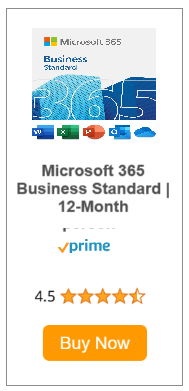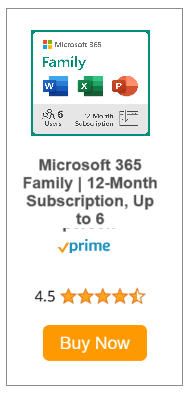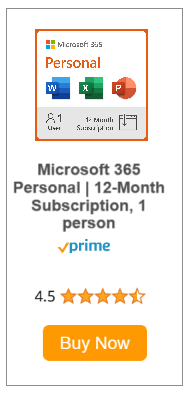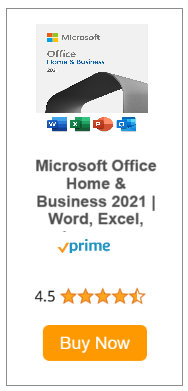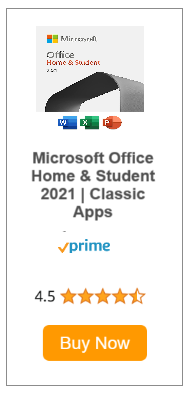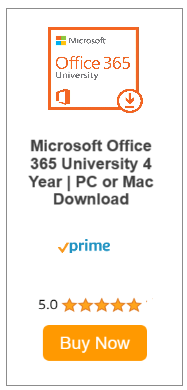Microsoft 365 Personal
Microsoft 365 Personal
Microsoft 365 Personal | 12-Month Subscription, 1 person | Word, Excel, PowerPoint | 1TB OneDrive cloud storage | PC/Mac Instant Download | Activation Required
Microsoft Office 365
Microsoft 365—the current name for the apps and services formerly known as Office 365—is the behemoth of office suites and the one every competitor tries to match. It runs almost everywhere, with full-featured editions for Windows and macOS, surprisingly powerful apps for iOS and Android, and slick web-based versions. Microsoft 365 has all the collaborative features found in cloud-only suites like Google Workspace, plus all the benefits of disk-based apps: speed, security, and the ability to work offline. Microsoft’s apps aren’t perfect, and a few features are awkward and unwieldy, but you’ll need strong reasons to choose anything else. Microsoft 365 is an Editors' Choice document-editing suite.
A Microsoft 365 Personal subscription costs $69.99 per year and includes access to Microsoft Word, Excel, PowerPoint, OneNote, Outlook, and Skype apps for one user on up to five devices. It also gets you 1TB of OneDrive online storage. You also get Sway for interactive online reports and presentations, forms for creating surveys and quizzes, and Microsoft's to-do list app, To Do. The Microsoft 365 Family tier provides access to the same apps and supports up to six users, each of whom gets their own 1TB of OneDrive storage. The premium version of the Microsoft Family app is included in this subscription tier, too.
Early in 2023, Microsoft announced an even cheaper option, Microsoft 365 Basic, which gets you 100GB of OneDrive storage and includes only the web and mobile versions of the apps, but it costs just $1.99 per month or $19.99 per year.

You can use Microsoft 365 on the web or download apps for Windows, macOS, Android, and iOS devices. Microsoft’s macOS version runs natively on both old-school Intel Macs and the latest Apple Silicon (M1) Macs. On Intel machines, Microsoft’s apps sometimes slow down when I’m impatient to get to work. On an Apple Silicon (M1) Mac, Microsoft’s apps run at breathtaking speed, a tribute to Apple’s hardware and Microsoft’s up-to-date engineering.
The right office suite for you may very well depend on the platforms and devices you use. Microsoft still does not offer versions of Office apps for Linux platforms—hopefully, the release of Edge for Linux is a sign Microsoft will more broadly support those systems. There's nothing to stop you from using the web-based version of any office suite on Linux. The open-source LibreOffice and SoftMaker Office offer dedicated apps for that platform.
Microsoft’s core apps—Word, Excel, PowerPoint, and Outlook have been growing and changing for almost forty years, and they’re stuffed with features that can sometimes make them seem heavy and unwieldy compared to relative newcomers like Apple’s Pages and Numbers. Also, Microsoft still uses a single app, Outlook, for the email, contacts, calendar, and to-do-list features other vendors, such as Apple and Google, have separated into smaller, sleeker apps that work together smoothly.


As far as the design of Microsoft's individual office apps goes, the company has clearly outdone itself. They’re easy on the eyes, highly customizable, and offer a spacious interface that feels at home in modern hardware in ways rival apps don’t. Microsoft keeps improving its Dark mode support, and the latest enhancements include subtle color-shifting effects. These are available now in the beta channel and will probably soon arrive in the release version. Another neat trick is that if you change a setting, such as the default color scheme, on one platform, the change automatically gets applied to all your Microsoft apps on other platforms.
Word and Excel are probably the most-used apps in the suite, and for good reason. Both run well, are highly polished, and get frequent updates that make them easier to use. For instance, while Excel already towers over all rival spreadsheet apps and has no trouble handling enormous worksheets without strain, Microsoft keeps adding features. One recent addition is the LET function, which enables you to use named variables inside a formula and insert that function multiple times in a worksheet; this makes calculations faster and easier to maintain. This is typical of the types of updates Microsoft 365 subscribers get, but which don't get added to the standalone Office version.
Both Word and Excel also offer conveniences you won’t find with any competitor. For example, Word makes it possible to type long documents in a viewing mode that shows the actual formatting on the page but hides the white space at the top and bottom of each printed page. That way, a sentence that extends across a page break doesn’t have two inches of white space between the beginning and end of it. Double-click on the space between pages to turn on this feature.

Here’s another example with Excel. If your worksheet has a list of people with their first names in one column and their last names in another, you can quickly build a column where each cell contains each person’s first and last name. Start by going to an empty column and typing the first person’s first and last names in the first cell. When you move to the next cell and begin typing the second person's first and last name, Excel offers to fill in the whole column with the first and last names of everyone else on the list. That's a smart and handy productivity feature.
Some of Word’s automated features can be annoying, however. For example, you may not want Word to format ordinals (the letters that follow the numbers in 1st and 2nd), but Word superscripts them automatically unless you backspace over the ordinal number and type it again. If you want to turn off this automated feature, you’ll need to know enough about Word to go to the Options > Proofing > AutoCorrect Options > AutoFormat section. Not many ordinary users will figure this out. Word has other bad habits too, such as inserting horizontal lines when you type a series of hyphens—another automated format feature that requires multiple steps to turn off. Word’s massive Options menu gives you some idea of the dozens of settings you can use to fine-tune the way Word formats and manages files.
Outlook manages to pack all its many features into an impressive package, but it can feel a bit overwhelming. For personal use, I prefer leaner apps like the open-source Thunderbird, commercial newcomers like Mailbird on Windows, and Apple Mail on the Mac. Even Windows 10's built-in Mail app has merits. But for corporate use, Outlook’s one-stop interface for managing mail, calendars, and contacts offers power and flexibility rivals don't.

Microsoft’s browser-based apps stand out for their elegance and usability, surpassing even the minimalist design of Google's Workspace suite. Like Google’s apps, Microsoft’s apps let you dictate text through a microphone as well as transcribe text from an existing recording. For me, Microsoft’s voice-to-text feature worked impressively well from mobile apps on a phone or tablet, but I could never get it to work inside a desktop or laptop browser on either a Mac or a Windows machine.
Microsoft’s Office apps are the best at what they do, bar none. If you want to exchange editable documents with anyone else, you’ll almost certainly want to send your documents in a format compatible with Microsoft's apps—a reasonable way to ensure everyone else can work on them. The only serious glitch I've found with Microsoft’s suite was the spotty online access I experienced on many browsers during testing. If you need to get serious work done in documents or worksheets, Microsoft’s suite is not merely worth the money, it's also an amazing bargain. For all these reasons, Microsoft 365 Personal is an Editors' Choice winner.
Our Verdict
Microsoft 365 is the standard for office suites and the only one that’s as powerful online as on the desktop. Nothing else comes close in power, flexibility, or ease of use.
 Micro Tools Reviews
Micro Tools Reviews
Useful Link
Disclaimer
microtoolsreviews.live is a participant of the Amazon Services LLC Associates Program, an affiliate advertising program which is designed to provide an aid for the websites in earning an advertisement fees by means of advertising and linking to Amazon products.


